The next-gen MacBook Pro with Retina Display Review
by Anand Lal Shimpi on June 23, 2012 4:14 AM EST- Posted in
- Mac
- Apple
- MacBook Pro
- Laptops
- Notebooks
Last year when I wrote about the new MacBook Airs I offered two forward looking paragraphs:
What happens from here on out is what's really interesting. Intel has already committed to moving the TDP of its mainstream parts from 35W - 45W down to 10 - 20W. Since the Air is the new mainstream Mac notebook, Apple has already made that move. The performance in this 10 - 20W segment is going to get much better over the next two years, particularly once Haswell arrives.
The Thunderbolt Display is the first sign of what's to come. Moving IO controllers and expansion into the display, and potentially even moving discrete GPUs out of the notebook are all in store for us. Apple is really ahead of the curve here, but it's easy to imagine a future where laptops become a lot more like the new Air and shift to a couple high bandwidth ports instead of numerous lower bandwidth connections.
Perhaps I was being too aggressive in the prediction of a couple of high bandwidth ports. After all, the next-generation MacBook Pro with Retina Display features four such IO ports (2 x Thunderbolt and 2 x USB 3.0). But you get my point. Gigabit Ethernet and Firewire 800 are both gone. The discrete GPU is still present but I suspect even its days are numbered, at least inside the chassis. The personal computer as we knew it for so long, is changing.
The personal computer is getting thinner, lighter, more integrated and more appliance-like. The movement is no longer confined to just Apple either. The traditional PC OEMs are following suit. Even Microsoft has finally entered the PC hardware business, something it threatened to do for years but hadn't until now. Distribution models will change, the lines between different form factors will continue to blur. What was once a mature industry is going through a significant transformation. It’s exciting but at the same time it makes me uneasy. When I first got into this industry everyone had stories of companies with great ideas that just didn’t make it. As we go through this revolution in computing I’m beginning to see, first hand, the very same.
Apple makes the bulk of its revenue from devices that don’t look like traditional personal computers. For the past couple of years I’ve been worried that it would wake up and decide the traditional Mac is a burden, and it should instead be in the business of strictly selling consumer devices. With its announcements two weeks ago in San Francisco, I can happily say that my fears haven’t come true. At least not yet.
It’s been a while since Apple did a really exciting MacBook Pro launch. Much to my surprise, even the move to Sandy Bridge, the first quad-core in a MacBook Pro, was done without even whispers of a press conference. Apple threw up the new products on its online store, shipped inventory to its retail outlets, updated the website and called it a day. Every iPhone and iPad announcement however was accompanied with much fanfare. The MacBook Pro seemed almost forgotten.
With its WWDC unveil however Apple took something that it had resigned to unexciting, dare I say uncool status, and made a huge deal about it. Two weeks ago Apple did the expected and offered relatively modest upgrades to all of its portable Macs, all while introducing something bold.
Apple calls it the MacBook Pro with Retina Display. You’ll see me refer to it as the next-gen MacBook Pro, Retina MacBook Pro, rMBP or some other permutation of these words.
After using it for the past two weeks I can honestly say it’s the best Mac Apple has ever built. And there’s a lot more to it than hardware.
Portability
If you were hoping for a 15-inch MacBook Air, that’s not what the rMBP is. Instead it is a far more portable 15-inch MacBook Pro. I have to admit I was a bit let down the first time I laid eyes on the next-gen MacBook Pro, it looks good but it doesn’t look all that different. The disappointment quickly faded as I actually picked up the machine and started carrying it around. It’s not ultra light, but man does it make the previous chassis feel dated.
While I never really liked lugging around the old MBP (and it always made me feel like the old fogey at tradeshows where everyone else had something 13-inches or smaller), carrying the rMBP is a pleasure by comparison. Pictures really don’t do it justice. The impressively thin display assembly or overall chassis thickness look neat in a photo but it’s not until you actually live with the rMBP that you can appreciate what Apple has done here. I carry around a 15-inch MacBook Pro because it’s my desktop, and as such it’s incredibly useful to have with me when I travel. For my personal usage model, the Retina MacBook Pro is perfect.
If your workload demands that you need the performance of a MacBook Pro and your lifestyle requires you to carry it around a lot, the reduction in thickness and weight alone will be worth the upgrade to the rMBP. If you spend most of your time stationary however, you’ll have to be sold on the display and internal characteristics alone. The bad news is if the design doesn’t get you, everything else will.

From left to right: 11-inch MacBook Air, 13-inch MacBook Air, 15-inch MacBook Pro, MacBook Pro with Retina Display
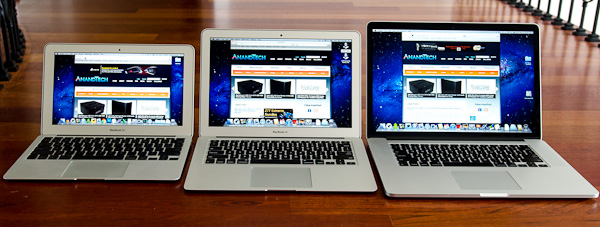
From left to right: 11-inch MacBook Air, 13-inch MacBook Air, MacBook Pro with Retina Display
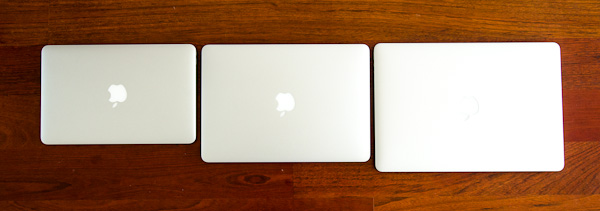
From left to right: 11-inch MacBook Air, 13-inch MacBook Air, MacBook Pro with Retina Display


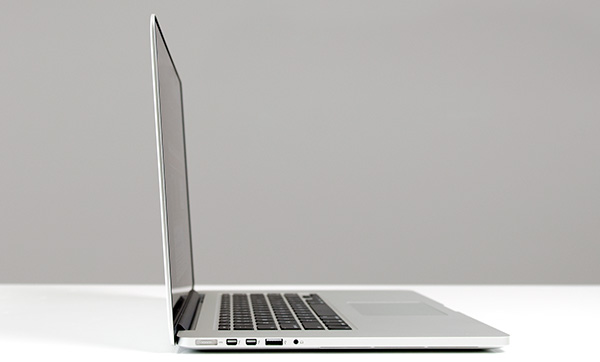
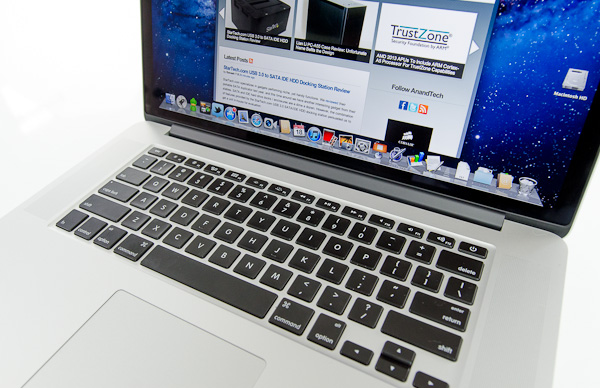
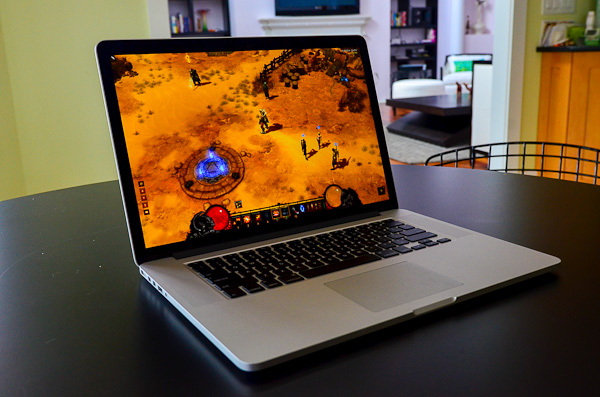
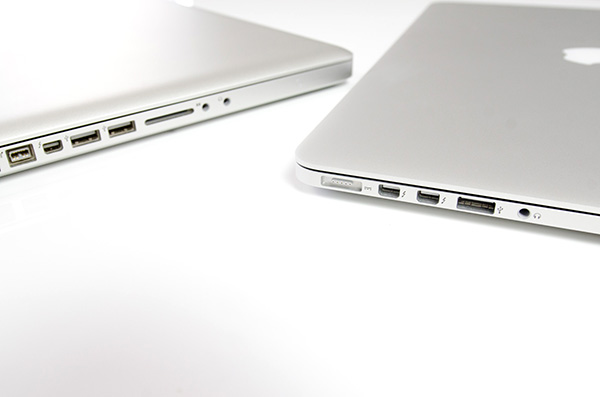
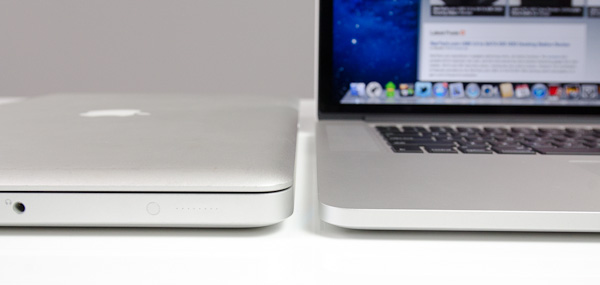








471 Comments
View All Comments
darkcrayon - Tuesday, June 26, 2012 - link
I hear you can work around that by not using that feature ;)Spunjji - Tuesday, June 26, 2012 - link
this is lost deep in the comments, so I doubt it will get any form of response. Nonetheless, while I feel this review has covered the ground incredibly well, there were some sever omissions that limit its usefulness.Where, for instance, are the comparisons to laptops that are not made by Apple? It's all well and good telling me that this laptop is cooler than its predecessor, but the trouble is that I didn't buy the 15" MBP because it turns into an unpleasantly hot and noisy beast as soon as you start gaming on it. Based on the surface temperatures you give, it sounds like this is no better with the new model *relative to non-Mac laptops* and yet I have no real way of knowing this for sure. I'd really appreciate that comparison - the same goes for battery life. In my case I currently use an Alienware M17x and would absolutely love to trade to something lighter with similar capabilities, but I need to know what the usability caveats will be.
I also feel that this site is asking us to take a lot on faith with regards to Thunderbolt. It's been a year and we can still only really attach storage to it outside of proprietary configurations, and even that doesn't work very well. We are also faced with the possibility that the first-gen tech will *never* work properly, yet it is still primarily mentioned as a good thing, with the rather horrible flaws pointed out deep within the bowls of a lengthy analysis.
flatform - Tuesday, June 26, 2012 - link
I am surprised not to see Anand commenting on the SEVERE problem that MOST users have with the Retina Displays -at least those mac users who are able to actually see a problem on their mac-. Advertising reasons maybe???Macbook Pro Retina -Plasma-TV-like(!!!!!)- Ghosting/Burn-in Issues
https://discussions.apple.com/thread/4034848?start...
IPad Retina issues: http://www.cultofmac.com/161495/new-ipads-retina-d...
Plus, the only reason for apple not to put gigabit is that the port did not fit in the new slimmer UPPER profile, not the case itself, it would had ruined their design lines, that is all!!!!! The 2012 Vaio Z is much slimmer but has a gigabit port, strangely implemented yet still there. Having worked for years with macs, we ALWAYS had the same problem, when you needed that adpter you had bought, it just wasn't -for any reason- there.... humiliating experience in front of clients...
having not normal SSD and especially no double slot configurable memory is probably just crap, 80% of laptops and desktops receive a hard drive and memory upgrade. just to shed off 100 Grams and 2mm of height?? 2009 Dell's Latitude Z600 was slimmer, 16inch displa, 2.0Kgs, yet had a normal hard drive and memory popped in.
Anand, with a 4 core/8 Thread Machine 16GB is BARELY enough TODAY, to work with Photoshop, Premiere, After FX and a RAW developer open, and still have free memory so that after fx can use all Threads. And That did not include one or 2 3D applications that a compositor would usually run. 16GB is the minimum, 32GB is the choice for the Video Professional. With so many programs switching to GPU processing, you should really be careful when commenting on the power of any machine with a dedicated graphic card.
For god's shake just wait and do not buy this crappy notebook. It is even more faulty than the first generation of 13inch Macbooks... wait at least 6 months for a proper revision, up to then Retina PC's will be available as well, with proper RETINA IPS displays with no burn-in issues and upgradeable parts.
darkcrayon - Tuesday, June 26, 2012 - link
I like how you mentioned the Vaio Z to bash the rMBP design, and then you went on to bash the rMBP for "limitations" that the Vaio Z also has (soldered RAM, though limited to 8GB, and more. Though off topic, your almost 3 month old iPad retina display problem is a nice touch, considering anyone with the problem could've gotten theres replaced for free. Please let us know which company is making millions of 260 ppi 10" screens with 100% perfect yields...flatform - Tuesday, June 26, 2012 - link
Comment on Vaio Z was just to point out stupid decisions who take into consideration only the looks of the machine, not direct comparison of the two machines, which are not comparable. Apple could have kept the same upper profile and diminish the lower bevel part. But it would not LOOK as thin. Let's see how professional Photographers -which i work with- will welcome the lack of FW800 and the need to echange 2-3 adapters to do one job, or the presence of only 2 USB's is a total failure when working in production environment. I am a professional industrial designer and compositor, believe me i would really like rMBP to serve me properly (i have been complaining about low-res screens since 2006) but it simply cannot. Replacing for free is the most logical thing to do and does not replace the evident problem. The iPAD is not of topic, it is a High PPI, same technology display which suffers from similar problems, just as the Macbook Display.My comment was that if Anandtech was serious about this review -respecting the readers that is- it SHOULD have mentioned -in a separate page with the fullest possible technical description- the problem in a clean and straightforward way, even if their sample did not have it (have they checked for it?)
When me moved from CRT's to TFT's (degrading our color reproduction, resolution and image quality) we did it because TFT;s had a hell less eyestrain, radiation, consumed less current and desk space. I cannot accepted that shedding off 150 grams (max) and 2mm of thickness from a WORKSTATION laptop is revolutionary and should force professionals to use adapters for the bluddy most used ports of their laptops, while depriving them from the most common upgrade in a notebook: memory and hard disk.
As for the last question, please let us know which company has developed the screen for apple and how many months later the same screen would be available in pc's as well.
Good thing Apple made the move, cause it has been FAR BEHIND in displays, (remember they where selling 1440x900 on 17" and 1280x800 on 15", then making it 1680x1050 and 1440x900 respectively, whereas a 1920x1200 15" screen was a common thing in mobile workstations) since they first brought a somewhat proper for graphic use display on their 2003 15" G4 Titanium. Workstation notebooks have IPS monitors for many years now.
robco - Tuesday, June 26, 2012 - link
Looking at the Googles, the news stories about the ghosting issues were posted today. Not something that likely would have been found before posting the review. This is a new display manufacturing process and there are going to be some mistakes. Never buy the first version, or at least the first production run, of any Apple product. This is one of the downsides to being an early adopter of almost any new technology. Apple tends to wait and collect data rather than acting rashly (see iPhone 4 fiasco). There isn't any data showing if this is a widespread problem, or only affecting a small percentage of units. But Apple will replace defective units.It took a little while, but third-party SSD upgrades are available for the MacBook Air. But on another note, would you expect *every* piece of equipment in your shop to be 100% user-upgradeable?
Everyone whined when Apple ditched floppies, serial, ADB and SCSI. There were adapters and people, well they adapted as well. I'm sure some will just buy a Thunderbolt dock (a couple are coming in a few months) and hook up all their peripherals and then connect them (as well as gigabit Ethernet) to the laptop with a single cable. Some folks may even be OK with trying desperately to live with only 16GB of non-upgradeable memory and have a bit more room in their bags and a bit less weight to schlep around.
But the beauty of the free market is that you get to vote with your pocketbook. If you're so terribly unhappy with the new rMBP, the old model, with new CPU and GPU upgrades) is still available. Show Apple your displeasure by sticking with the old design. Or by a fragile Sony laptop. Or a Dell Precision. Nobody is twisting your arm to make you buy this thing. Lots of other people will gladly accept the trade-offs and be happy with their lighter, thinner, quite powerful rMBPs...
flatform - Tuesday, June 26, 2012 - link
haha, good one "adapters that people adapted to" hahhaha. A good comment in general, covering most of the topics and dare i say most of the people in this page.wfolta - Tuesday, June 26, 2012 - link
I stopped reading when you said "most users have", which is obviously not true.flatform - Thursday, June 28, 2012 - link
Good thing to do, i am sure that made you wiser. Truth is a floating mean point of falsifications. (will not continue because you must have stopped reading already ;)pirloui - Thursday, June 28, 2012 - link
"SEVERE problem that MOST"That would rather be "some" and "some".